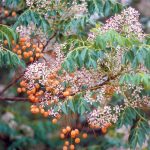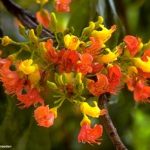TREE LIFE
March 2016
MASHONALAND CALENDAR
Saturday 5th March: Botanic Gardens Walk. We meet in the main car park at 0845 hours for a 0900 start. This walk will last for 1h 30min.
Sunday 20th March : Return visit to Bob Warren Codrington and Bill Bedford’s property off Alpes Road. Bob has very kindly invited us again. We will not be attempting to get down to the Mazowe headwaters again, but plan to work downstream from the dam area. We found some very interesting trees in the short walk we did after lunch there last time.
Saturday 26th March: EASTER – no outing
CORRECTION: KEY TO SOME TREES OF THE
HIGHVELD & MIDDLEVELD
During the visit to Hildemara last year Key to the Trees of the Highveld and Middleveld failed to lead to the identity of Englerophytum magalismontanum when the milky sap was not visible. I have reworded paragraph 24 on page 45 as below, which I think will work. Unfortunately the formatting of Tree Life is not the same size as the key and so I have a prepared a pdf file with the correction in the exact size which can just be cut out and stuck in over the top. If anyone would like to do that please send me an email megcp@zol.co.zw and I will send it to you.
On Page 45: Change the following:
24 a. Leaves with many (more than 20) pairs of lateral veins, parallel, close together, almost reaching the margin ……………………………………………………………26
b. Leaves with few lateral veins, if visible, irregularly spaced apart, curling around or fading out before the margin ……………………………………………………………25
TO
24 a. Leaves with many lateral veins, distinctly ridged on one or both surfaces, parallel, close together, almost reaching the margin ……………………………………………….. 26
b. Leaves with lateral veins, if numerous indistinct, if distinct, irregularly spaced apart, curling around or fading out before the margin ……………………………………………………………25
– Meg Coates Palgrave
REMINDER – RECIPROCITY
National Trust – we have free entry to all their properties in Zimbabwe and the specific benefits accruing to them. Some of these places are: Rhodes Nyanga Historical Exhibition; World’s View, Nyanga; Murahwa’s Hill, Mutare and La Rochelle Estate and Hotel, Penhalonga. La Rochelle has a historical house and magnificent gardens recently redesigned and landscaped following the original design by Lady Virginia Courtauld. La Rochelle boasts a superb orchid collection and the Dell, a natural indigenous area of Cycads and Aloes. We are entitled to 10% discount on accommodation (bed and breakfast).
Booking: reservations@larochellecentre.com NTZ websites: www.ntzimbabwe.org & www.notz.org.
Nyanga Downs Fly Fishing Club (NDFFC) – we can use their two self-catering cottages on the Gairezi River, Nyanga (each cottage sleeps four). There are also camping facilities with a gazebo, solar showers and ablutions.
There are wonderful walks along the river, with plenty of indigenous riverine bush and some fantastic birding.
Available: Period 1: 1st Jan to 31st March; and Period 2: 15th June to 31st July.
For more details and to book (preferably four weeks in advance), contact:
NDFFC Offices at 4 Mount Road, Avondale, Harare (Contact persons Fey or Margie – e-mail address: sales@dpz.co.zw or phone 04334708.
Members need to show a Tree Society membership card for the above – contact me for the card.
– Tony Alegria
FUMIGATION OF THE HERBARIUM AT HARARE BOTANICAL GARDENS
For a number of years we have paid for the Herbarium to be fumigated. We were overdue for the fumigation last year and I thank Fumigation Services for responding so timeously to my request. They fumigated on Christmas Eve, having given us a discount and treating the exercise as a community service project. Thanks ever so much, this is much appreciated.
– Tony Alegria
VISIT TO MUKUVISI WOODLANDS SUNDAY 17 JANUARY 2016
Botanising in the Mukuvisi Woodlands for a novice like me? What a wonderful experience! The Tree Society has been investing in training new leaders for our outings so Teig Howson, Tony Alegria and Bilal Khatri led us through the park with a wealth of expertise. They each took turns identifying a tree in detail thus providing a textbook example of how to identify a tree species. Some of the miombo species that we observed together included:
Azana garckeana; Combretum molle, Bush willow; Diospyros mespiliformis; Faurea saligna, Willow beechwood; Gymnosporia senegalensis; Peltophorum africanum African wattle; Pterocarpus rotundifolius; Pseudolachnostylis maprouneifolia, Duikerberry or Kudu berry; Senna singueana, Syzygium cordatum, Waterberry; Syzygium guineense; Vitex payos, Chocolate berry.
We concluded our outing with a lovely tea at the picnic tables where the Bird Life Zimbabwe regularly meets.
– Erica Rioux Gees
VISIT TO THE HARTUNG‘S GARDEN SATURDAY 23 JANUARY 2016
On Saturday January 23rd, Dave and Olwen Hartung hosted a group of 20 at their home in Mt, Pleasant. The Hartung’s garden contains over 110 documented species of trees and shrubs. Dave led the tour starting with the Vitex nigundo, also known as the Chinese chastetree. Widely used in folk medicine in South and Southeast Asia, V. nigundo is part of the Lamiaccae/Labiatae sage family. Their opposite, palmately compound leaves make them a very easy group to identify. We later saw a Vitex trifolia cultivar ‘purpurea’, Arabian liliac with its characteristic purple leaves.
The genus Vitex was named by Linnaeus but also used by Pliny the Elder who named Vitex agnus-castus. It is derived from the Latin vieo, meaning to weave or to tie up, a reference to the use of Vitex agnus-castus in basketry. In the 1990s the Vitex genera was transferred from Verbenaceae to Lamiaceae after phylogenic studies, with the help of DNA mapping, revealed the connection to this family.
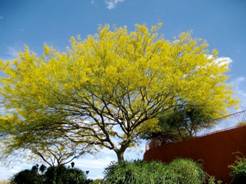
Parkinsonia aculeata tree
Other trees on the tour included the Parkinsonia aculeata – also known as the Jerusalem thorn; Retama Broom bush; Palo verde, Green stick or pole); Mexican Palo Verde; and Horsebean or Lluvia de Oro (Gold Rain). The word Jerusalem is a phonetic corruption of the Spanish and Portuguese word girasol which means “turning toward the sun”. I remembered this unusual tree from my travels through Mexico and decided to learn a little more about this species.
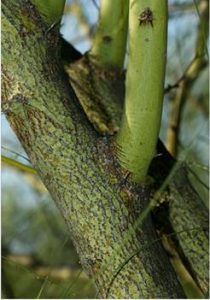
Green bark of Parkinsonia aculeata
The genus Parkinsonia is part of the Fabaceae/Leguminosae or Pea family. Containing 12 species, the trees are native to the semi-desert and arid regions of Africa and the Americas. They share the characteristic thorny crown and greenish bark with pinnate or bipinnate leaves with small deciduous leaflets. Flowers vary in colour from all yellow with orange spots to all white, with varying combinations in between.
The Parkinsonia aculeata we saw is native to Mexico and the Galapagos Islands. It has been introduced as an ornamental tree around the world. Its natural habitat ranges from northern South America to the southern United States. It is a drought resistant tree that adapts its growth to its environment: attaining heights of up to 10 metres of dense foliage in moist humus-rich environments. or growing as a shrub of 2 to 8 metres in dry areas.
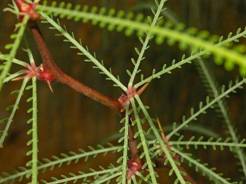
Parkinsonia aculeata leaves
The leaves have short stalks, they are bipinnate with 1-3 pairs of leaflets that consist of a long, flattened, prominently ribbed central axis 20 to 40 cm long and 2 to 3 mm wide, ending in a short spine. The leaves are edged on both sides with numerous, oblong secondary leaflets 4 to 10 mm long which become deciduous in dry conditions, leaving a long thin photosynthesising stalk. At the axil of each leaf is a needle-sharp spine 5 to 15 mm long, in a characteristic two-short-one-long thorn pattern. The slender stems can be either drooping or zigzag in form.
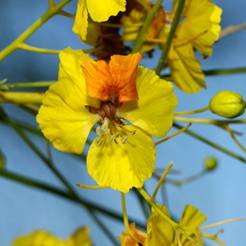
Parkinsonia aculeata flowers
The flowers are predominantly yellow in groups of 8 to 12, on a long slender stalk arising from the leaf axils. Typical flower size is 2 cm in diameter and consists of a bilaterally symmetrical, 5-petalled corolla. Flowers have four 6 to 15 mm petals which are reflexed with a singular orange-coloured or spotted erect petal on the top. The flowers are pollinated by Centris pallida a species of solitary bee which has been called the digger bee, the desert bee and the pallid bee due to its actions, habitat, and colour respectively. Like the climate-adaptive Parkinsonia, these bees have also evolved to withstand the high temperatures of their native habitat. Centris pallida routinely has internal temperatures within 3oC of death.
The fruit is light brown, shortly-stalked, sharp pointed pod 3 to 13 cm long, about 7 mm wide, with bulging and constriction between the seeds. Seed colours vary and propagate differently depending on the season.
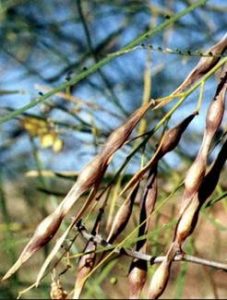
Parkinsonia aculeata pods
Propagation occurs through the seed pods which are dropped in to the water and washed downstream by seasonal flooding. Seeds will remain viable for a long time – without the scarification process of the stream beds, the plant is very slow to germinate. However, the early light-brown seeds can grow immediately. The roots have a shallow main axis and numerous surface laterals. The seeds were harvested and sun dried by Native Americans for storage and later roasting over dry heat before eating.
The tree is now considered a major invasive plant in Australia and Hawaii, where it has become a problem for humans and livestock since it forms dense thorny thickets in riparian areas, preventing access to water and crowding out native species.
Plant names are always fascinating to me so I wanted to understand who was commemorated through this genus of unusual trees.

John Parkinson (1567–1650)
The name Parkinsonia honours John Parkinson (1567–1650), one of the first great English botanists and one of the last great herbalists. He was the influential author of two monumental works, Paradisi in sole paradisus terrestris (Park-in-Sun’s Terrestrial Paradise – 1629) and Theatrum Botanicum (The Botanical Theatre or Theatre of Plants – 1640). Paradisi is considered the earliest treatise on horticulture. This illustrated work is written in a homely, literary style, that presents a complete picture of English gardening in the early seventeenth century. The book includes not only herbals, medicinal plants and food production, but also the pleasurable side of gardens.
Parkinson was a pious man who saw the botanical world as an expression of divine creation. With a dose of caution, he believed a bit of Eden could be recaptured in each garden as long as the gardener set aside his arrogance and hubris. This belief is evident in the title page of his first book Paradisi.
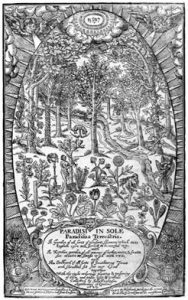
John Parkinson’s first book – Paradisi
The work is illustrated with 108 mostly original woodcuts depicting multiple species made by the German artist Christopher Switzer. The unusual title page depicts Adam and Eve in the Garden of Eden gathering food beneath a canopy of fruit trees, vines, giant cyclamens, lilies and carnations. In the background sits the mythical Scythian or “vegetable” lamb growing from a central stalk attached to its stomach. Thought by some to provide a link between animals and plants, the Scythian lamb was an animal that was reputed to have flesh that tasted like fish, blood that tasted like honey, and golden wool. It was also supposed to grow and propagate itself like a plant, being attached to the ground by a stalk that would bend down to allow it to graze. It is a fitting symbol for a treatise that brings beauty, inspiration and nourishment to the home garden.
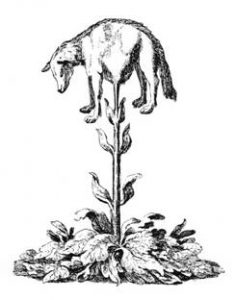
Mythical Scythian
He dedicated this work to Queen Henrietta Maria, who he was tutoring on gardening at the time. Charles I then gave him the title of Botanicus Regius Primarius (first botanist to the King).
Parkinson was an apothecary by profession. In 1622 he left his profession to focus on his garden at Long Acres in Covent Garden. While little is known about the garden, research reveals 482 types of plants were grown there. His work and garden are referred to and cited by many of his contemporaries in their published works.
Parkinson was the first to describe 33 native plants such as the common Welsh Poppy, the Strawberry Tree and the Lady’s Slipper, which had gone unnoticed and unrecorded by his predecessors. He also financed various plant hunting expeditions to Iberia and North Africa in 1607-1608 and was responsible for the introduction of seven new plants to England, including the great double yellow Spanish daffodil.
During our visit with Olwen and Dave Hartung, we were able to see many other trees before our delicious tea together. A big thank you to both for hosting such a lovely afternoon and sharing a part of their Eden with all of us.
Sources:
Kings College ISS – Book of the Month
https://web.archive.org/web/20070526185732/https://www.kcl.ac.uk/depsta/iss/library/speccoll/bomarch/bomapril05.html
Lady Bird Johnson Wildflower Center – Parkinsonia aculeata
https://www.wildflower.org/plants/result.php
PIER: Parkinsonia aculeata https://www.hear.org/Pier/species/parkinsonia_aculeata.htm
Schede di Botanica – Parkinsonia aculeata
https://luirig.altervista.org/flora/taxa/index2.php?scientific-name=parkinsonia+aculeata
Southeastern Arizona Wildflowers and Plants
https://www.fireflyforest.com/flowers/1833/parkinsonia-aculeata-jerusalem-thorn/
Tree Atlas of Namibia – Parkinsonia africana
https://treeatlas.biodiversity.org.na/viewspec.php?nr=437
Wikipedia – John Parkinson
https://en.wikipedia.org/wiki/John_Parkinson
Wikipedia – Parkinsonia
https://en.wikipedia.org/wiki/Parkinsonia
– Erica Rioux Gees
MEANINGS OF SCIENTIFIC BOTANICAL NAMES
Acacia amythethophylla (pronounced A-KAY-SEE-AH AM-EYE-THITH-OH-FILL-AH)
The stem aca- of the name of the genus comes from the Latin acanthus meaning ‘a thorny evergreen Egyptian tree’; the related Greek word akis {ἀκις} (there is no letter ‘c’ in Greek) means the point or barb of an arrow or hook, while akantha {ἀκανθα} means a thorn, prickle or prickly plant such as a thistle; thus the numerous species of trees with straight or hooked thorns or both (and bi-pinnate leaves) rightfully belong to the genus Acacia.
The Greek word amuthetos {ἀμυθητος} [pronounced am-ee-thay-tos] means ‘a great many’ or ‘unbelievably many’ while phullon {φυλλον} [pronounced fill-on] means ‘a leaf’, so the specific name presumably refers to the large number of little leaflets (pinnules) on the pinnae. The leaves of A. amythethophylla are the largest of all our indigenous Acacias.
It is useful then to remember that names beginning with or containing aca- or aka- (e.g. Acanthaceae) will usually refer to thorns or prickles of some sort, and names which contain the letters -phyll- will have something to do with the leaves. Note that in Greek the capital letter ‘U’ (upsilon) is written like our ‘Y’, so many terms which have ‘y’s in them would have had ‘u’s in the original Greek.
Brachystegia glaucescens (Pronounced BRAK-EE-STEE-JEE-AH GLAW-KESS-ENS )
It is quite hard to say exactly what the generic name means! Brachus {βραχυς} [brak-iss] in Greek means ‘short’, in time or space, and all the words with the stem steg- refer to covers or rooves; what this might refer to on the tree I do not know ― maybe someone out there can enlighten me?
The specific glaucescens is much easier to deal with: glaukos {γλαυκος} in Greek means ‘gleaming, silvery, or bluish-green’ and from the Latin, glaucescens means ‘tending to be bluish-grey’, referring clearly to the colour of the mainly smooth bark of these lovely trees; the alternative name of B. tamarindoides refers to the rather finely pinnate leaves which are somewhat like those of the Tamarind. The common name of Mountain acacia is of course a total misnomer!
The English word ‘glaucous’ means ‘light bluish-grey’ or having a whitish-grey coating which rubs off easily (like the bloom on some fruit).
Erythrina latissima (pronounced EH-RITH-RYE-NAH LAT-ISS-IMA)
The Greek word eruthros {ἐρυθρος} means any colour red (e.g. red wine) and all the Coral or Lucky Bean Trees have red flowers, hence the generic name. The stem eryth- occurs in a number of other names as well.
In Latin the word latus means ‘wide’ (the English word ‘lateral’ comes from this); latissima is the superlative form, meaning ‘very wide’ or ‘widest’. The Erythrina species have trifoliolate leaves and the leaflets of this one are really huge; I have measured some of the main base leaflets at 30cm across. The other 3 species in Zimbabwe are E. lysistemon, E. abyssinica & E. livingstonii; when ‘i’ or ‘ii’ is tacked onto the end of someone’s name it simply means ‘of that person’, so E. livingstonii is Livingstone’s Erythrina in English.
Megaskepasma erythrochlamys (pronunciation : MEGA SKEP PAS MA EH REE THRO CLAM ISS)
The wonderful scientific name of the Brazilian Red Cloak, a quite spectacular bush when in flower, seen in many gardens, can be broken down into four Greek words like this:-
Mega {Μεγα} = Large;
skepasma {σκεπασμα} = a covering or blanket;
erythro(s) {ἐρυθρος } = red;
chlamys {χλαμυς} = a cloak.
So it is a red cloak made from a big blanket! [or a large red cloak, covering like a blanket –Ed].
Strongylodon macrobotrys (pronounced STRONG GHEE LO DON MAKRO BOT RISS)
Another gorgeous plant, this is the Jade Vine from the Philippines which also gets its scientific name from Greek:-
Strongyl(o) {Στρογγυλλω} = to spin or twist as in rope (the English word ‘strangle’ may come from this);
odon- is from the word for tooth {οδους, οδοντος} (from which ‘dentition’ is derived);
macro- {μακρο-} = long;
botrys {βοτρυς} = a cluster or bunch, as of grapes.
Thus we have a long bunch or rope of twisted teeth, which is quite descriptive of the fang or claw-shaped flowers.
Terminalia sericea (pronunciation: TERM INN AY LEE YA SER RESS SEE AA)
Back to indigenous trees and a Latin name this time, for the Silver cluster-leaf Terminalia. Terminalia refers to the way the leaves grow in terminal clusters at the ends of the twigs.
The specific name sericea is derived from ‘serica’, meaning silken garments; ‘Sericus’ means Chinese, people who were famous for their beautiful silks; the English term sericulture or sericiculture refers to silk production. When young, the leaves of this tree are an attractive silvery-green colour and have a soft silky texture.
With the related Terminalia mollis & Combretum molle, the specific names mean soft, referring to the velvety texture of the leaves. (Terminalia is feminine and Combretum is neuter and in Latin the adjective has to agree with noun, hence the different endings –is and -e.)
– Dave Hartung
TONY ALEGRIA


